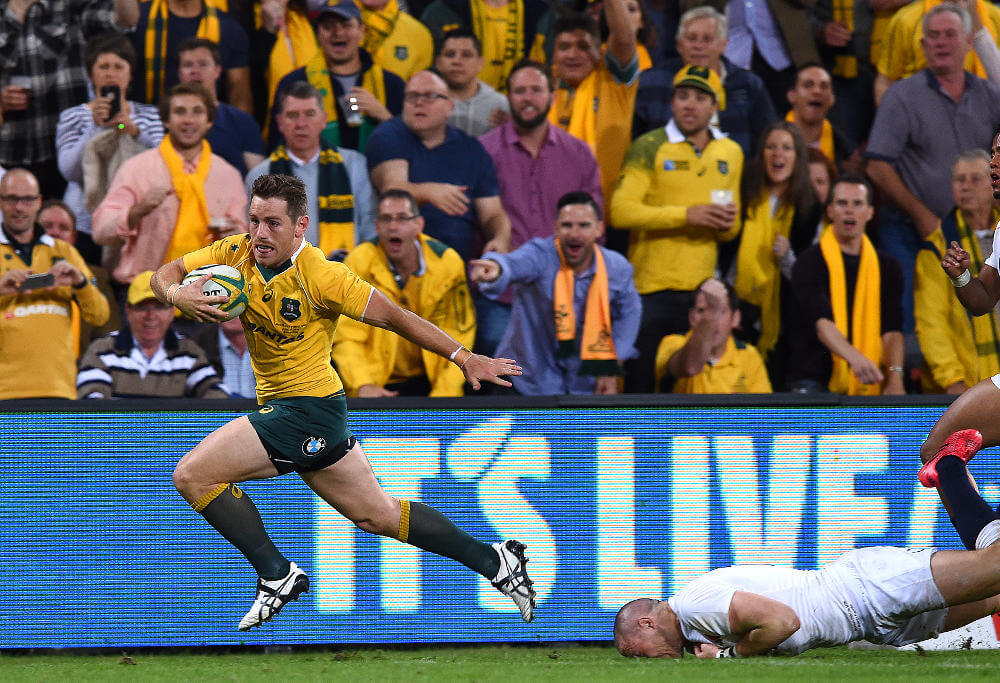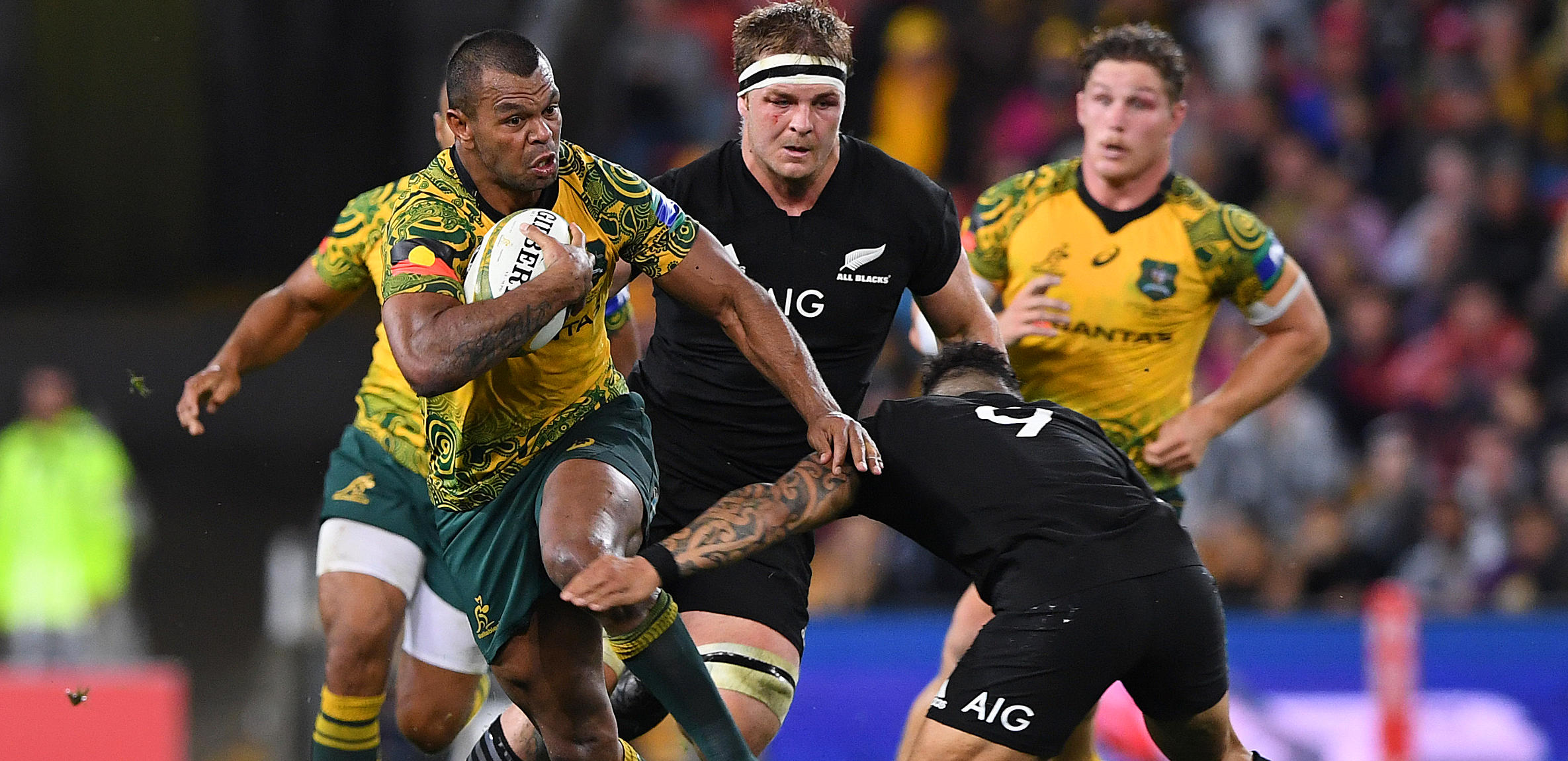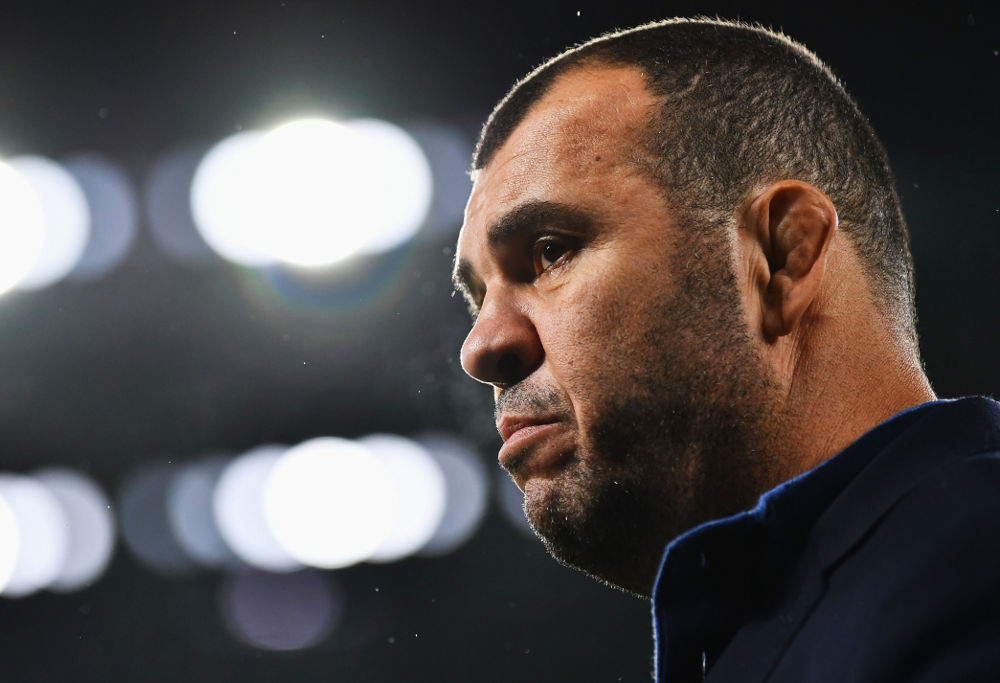The Wallabies brains trust have publicly refused to adopt the 2-4-2 attacking structure that has been so successfully used by the All Blacks and have instead conjured up the ‘Australian way’, which is basically the 1-3-3-1 attacking structure. But is this really the Australian way?
The classic 1-3-3-1
This structure has the forwards setting up in four pods across the field in a 1-3-3-1 formation. The two flankers usually set up inside the 15 metres ‘tram tracks’ on either side of the field, forming the outside two pods. Two pods are also set up in the middle of the field between the two 15-metre lines. These two pods usually consist of the front row (one, two and three) and the locks and eighth man (four, five and eight).
The wingers, who are usually selected as big strike runners, stick with the two flankers on either side of the field and thus help form the two outside pods. Usually only one playmaker is selected at ten, and this playmaker usually drifts between and behind the two middle pods to create and continue play. The inside centre, outside centre and fullback usually divide themselves into the three channels that are created between the pods or roam between the three.
The two three-man forward pods in the middle usually arrange themselves in an arrowhead with the lead man being the ball receiver. This allows the option for them to pass the ball to the runner on either side of them or pass it ‘out the back’ to their playmaker, who sweeps behind and across their pod.
[latest_videos_strip category=”rugby” name=”Rugby”]
The two runners on either side of the ball receiver usually run hard lines to ‘fix’ the defender opposite them so that when their playmaker comes from behind and around the ‘corner’ of their pod, he has more time and space to work with instead of being faced with a forward defender who moved laterally.
This structure creates three attacking channels between the forward pods, which is one more than in its 2-4-2 counterpart. It also creates four forward pods, which is again one more than its 2-4-2 counterpart.
Having the extra forward pod and having four pods spaced across the field, means that the ball does not have to travel too far before it again reaches the safety of a forward pod. This means that many phases can be built up while retaining ball security.
Each of the three attacking channels has its own runner. Conversely, it gives the playmaker three attacking options into which direct play. Usually all the play is directed by the one playmaker, which provides some sense of authority and clarity, with the remaining backs being strike runner options for the playmaker.
It is a more conservative structure than its 2-4-2 counterpart but still allows for attacking rugby via the extra attacking channel that is created. In essence it is a compromise between the more adventurous nature of the 2-4-2 and traditional phase-play rugby.

(AAP Image/Dave Hunt)
Slight variations
The Wallabies brains trust have tweaked this structure somewhat. They are selecting another playmaker at 12, which is not unusual. This means that there are now two playmakers.
The usual way to utilise this selection set-up is for each playmaker to stand behind each of the two three-man pods in the middle. However, this is rare in the Wallabies set-up from what I can see and instead the inside centre keeps roaming along with the outside centre and fullback and basically acts as a second playmaker in one of the attacking channels.
They have also been forced to select a ‘second fullback’ on the wing instead of a big strike runner due to defensive/kicking concerns. Having two big wingers is a hark back to the Rod McQueen days and the phase play/ball-in-hand approach, but lethal exposure of a lack of kicking game, especially by the All Blacks, has forced a reconsideration.
Due to their selection of a second openside flanker at eighth man it is now the eighth man who lines up with the winger in the pod on the side of the field. But I have also seen this changed so that the actual blindside flanker lines up here even though a second openside has been selected at eighth man.
The two flankers in the pods on the side of the field are given licence roam and inject themselves almost anywhere and at any time across the field, especially Michael Hooper. However, wsually the intervention of the flanker is limited to their ‘half’ of the field.
The three forwards in the middle two pods also don’t line up in an arrowhead formation. Instead they line up in a straight line with the forward in the middle usually still being the first receiver. More on this later.

(AAP Image/Dave Hunt)
False promises
This structure promises attacking rugby by being able to keep the ball in hand, build phases and be provided with an extra option through which to attack. This sounds very Australian given it was so successfully used by the Rod McQueen-era Wallabies, but these promises rest on false foundations.
Having four pods across the field automatically reduces open space and also drags the defenders across the width of the field. Although there is an extra attacking channel, these channels are much narrower than those in their 2-4-2 counterpart. The narrow channels also get easily congested with stray opposition forwards, and stopping this from happening is very difficult.
In order to keep the three narrow attacking channels clear the attacking forwards have to be dominant at the contact point and at the breakdown. No dominance – no committal by opposition forwards – means more spread in defence by opposition forwards. This problem gets severely compounded by a team who defends by not committing to breakdowns and rather spreads across the field – for example, the All Blacks and England on their recent tour Down Under.
The attacking promise held by the extra attacking channel thus rests squarely on forward dominance, and this is where the whole system in Australia’s case falls down. Clear and obvious forward dominance between teams is becoming less and less common in international rugby, and there is almost none between the top tier nations.
Teams like Scotland have also had great success against the Wallabies by simply slowing the ball down at the breakdown and giving their forwards the chance to realign and congest the three attacking channels.
The Wallabies brains trust must know all this, but it seems that despite this they are persisting with the 1-3-3-1. It seems that they are trying to solve this problem by throwing bigger forwards at it and working overtime on urgency at the breakdown.

(AAP Image/David Moir)
Other problems
Energy efficiency. In order to keep the attacking channels open and play attacking rugby, the forwards have to work overtime by continually and directly dominating the contact and clear the breakdown. This cannot be kept up effectively for the entire 80 minutes. The answer to this problem apparently lies in making the players fitter by running up hills with their mouths taped shut.
The promises of the ‘options’ contained in the middle three-man pods are also illusory. Once the ball receiver in these pods ‘pops’ the ball to the runner beside him, they get tackled and taken out of the game for a split second, which means only the other pod member can immediately attend on the breakdown, which is very risky and easily exploited.
I have noticed that after the recent England tour Down Under the Wallabies brains trust have scrapped the arrowhead formation and instead opted for the three-man line set-up. My guess is that they probably consider that by having the three forwards line up next to each other they can create more guesswork or hesitation for the defence as to who is receiving the ball while still maintaining the backdoor option.
The two-man pods on the side also don’t really provide ball security if one of them has to take it into contact. The outside centre or fullback usually runs laterally to help secure the breakdown, and many times I have seen members of the three-man pod also having to move laterally to help secure the ball. Again, more moving parts, more individual movement and more energy wasted.
This structure also does not have the eagle-eye attacking view from the fullback and outside centre as the 2-4-2 structure does. It may seem minor, but this eagle-eye view can see play developing and gaps open up much quicker than a playmaker who is playing close to or in the line.
Lastly, this structure takes longer to set up, which means the attack takes longer. Apart from having more moving parts, the ball has to travel through or behind two pods to reach the other side of the field, which creates valuable seconds for a defence to realign. The crux of this structure is also that the ball has to be hit up by at least one of the two middle pods for the attack to really kick-start, which, again, takes longer.

(Dan Mullan/Getty Images)
The Australian way?
I can see how the 1-3-3-1 attacking structure was seen by the Wallabies brains trust as a natural fit for the way rugby is or was played in Australia. It promises ball retention, phase play and attacking options of the Rod McQueen era and even has the second wave of attack by having the playmaker/s stand behind the two middle forward pods, and influence of rugby league influence.
The problem is that this all rests on forward dominance, and this is where I take issue with this ‘Australian way’. This structure and the forward dominance it requires may have worked at club level and even at Super Rugby level, but it does not work at international level. And if it is used at international level, it is by teams who are traditionally conservative and play a forward-orientated game, such as the South Africans.
On a side note, the Wallabies brains trust and the Springboks – because they are also trying to implement the 1-3-3-1 formation – have taken false confidence from some of their performances against the All Blacks in 2017. It was clear that the All Blacks were experimenting with working on different defensive structures while developing a host of new players.
Although successful Wallabies teams gone by have had forward packs who could do the job at hand, they never had an obvious and clearly dominant forward pack. When I think of classic Wallaby teams of the past, I think of teams who played smart, skilful, evolutionary and backline-orientated rugby.
So I have to ask: is the less confrontational, more energy efficient and more entertaining attack-orientated 2-4-2 structure not more suited to the way rugby is and was played in Australia rather than the 1-3-3-1 structure that requires constant forward dominance?

































































































